The practice of dentistry encompasses an amazing array of services and procedures, all with a common goal: to help you to preserve your natural teeth as long as possible, ensure your oral health, and keep you looking and feeling great throughout life.
There’s so much that can be done these days to improve the appearance of a person’s smile — at any age. From powerful, professional whitening treatments to amazingly realistic porcelain veneers to state-of-the-art dental implants, there’s a wide range of exciting possibilities.
The first step in any smile makeover is a thorough dental examination to make sure that your cosmetic problems really are just that, and not a sign of underlying dental disease. Once your health has been established, your smile can be cosmetically enhanced in a variety of ways.
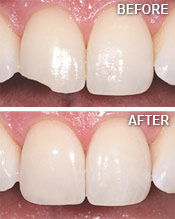
Cosmetic Tooth Bonding
We are proud of the ways in which dentistry can restore broken or decayed teeth to full beauty and function. One of the easiest and least expensive ways of doing this is with dental bonding.
Bonding uses tooth-colored materials to replace missing tooth structure or hide cosmetically unappealing minor defects in a tooth — chips, discoloration, and even minor spacing irregularities. Bonding materials are called “composite resins” because they contain a mixture of plastic and glass, which adds strength and translucency. The composite actually bonds, or becomes one, with the rest of the tooth.
Composite resins come in a variety of tooth shades for truly lifelike results. When bonding is done with a skilled hand and an artistic eye, it may be impossible to distinguish the bonded tooth from its neighbors. Though bonding will not last as long as a dental veneer, it also does not require the involvement of a dental laboratory and, most often, can be done without drilling of the tooth. It’s a particularly good solution for teens, who often need to wait until their teeth have finished maturing before choosing a more permanent type of dental restoration.
Crowns and Bridgework
Dentistry is an art as well as a science; dental crowns offer a perfect example of this. A dental crown or “cap” is a covering that fits over a damaged, decayed or unattractive tooth. It can even replace a tooth entirely as part of dental bridgework.
A crown completely covers a tooth above the gum line. This is in contrast to a dental veneer, which only covers a tooth’s front surface and needs natural tooth structure to support it. Therefore, if a tooth is missing a significant amount of structure above the gum line, a crown would be the restoration of choice.
Crowns strengthen damaged teeth, allowing them to function normally again. When crafted from today’s high-tech porcelains (dental ceramics), crowns are virtually indistinguishable from natural teeth. They can even be designed to improve upon a tooth’s original appearance.
There are other materials besides porcelain that we can use to make dental crowns, depending on what qualities are most important. For durability, cast gold can’t be beat. However, this is not always the most aesthetic choice — especially towards the front of the mouth. Other possibilities include porcelain-fused-to-metal crowns (PFM), which have a metal interior for strength and a porcelain exterior for a more natural appearance, and all-porcelain crowns with zirconia, representing the strongest ceramic. We would be happy to discuss the pros and cons of these various options with you.
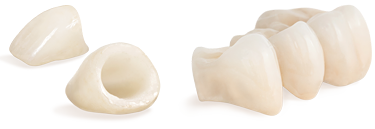
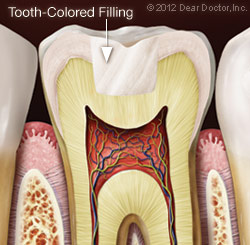
Fillings
If you have never had a cavity, congratulations! If you have had one, you are not alone. About 78% of us have had at least one cavity by the time we reach age 17, according to a 2000 report by the U.S. Surgeon General. Fortunately there’s a time-tested treatment for cavities: the dental filling.
Fillings do just what the name implies — seal a small hole in your tooth, i.e., a cavity, caused by decay. This prevents the decay (a bacteria-induced infection) from spreading further into your tooth and, if untreated, continue on to the sensitive inner pulp (nerve) tissue located in the root canal. Should that happen, you would need root canal treatment.
There are a variety of materials used to fill teeth these days, but the process of filling a tooth is similar regardless. The first step is a clinical exam of the tooth with x-rays, to determine the extent of the decay. Then the decayed area of the tooth is removed, usually with a handheld instrument such as a dental drill. Of course, your tooth will be anesthetized first, so you won’t feel any discomfort. If you normally feel nervous about receiving numbing injections, it’s possible that taking an anti-anxiety medication or using nitrous oxide can help you feel more relaxed. After removing the decay, the remaining tooth structure is roughened or “etched” with a mildly acidic solution; then translucent cement is applied to bond the tooth and the filling material together.
Gummy Smiles
Some people feel self-conscious about smiling because they believe their gums are too prominent. Though we each have our own definition of what makes a smile beautiful — including how much gum is too much — a smile will usually be perceived as “gummy” when 4 millimeters (just over an eighth of an inch) of gum tissue shows. If your smile looks gummy to you, it’s important to figure out exactly what’s causing this. Only then can the appropriate cosmetic dental or periodontal (gum) procedures be recommended to give you a more pleasing appearance of the gums and teeth.
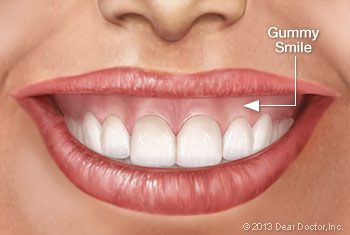
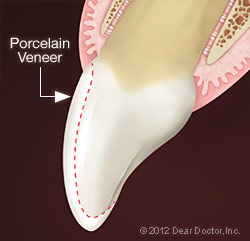
Porcelain Veneers
What makes a smile beautiful? That’s a complex question, but some qualities of a lovely smile are immediately identifiable: good tooth color, shape and alignment are a few of the most important ones. If your teeth could use improvement in any of these categories, porcelain veneers could be just what you’re looking for.
You may already know that a veneer is a thin covering over another surface. In dentistry, a veneer is a wafer-thin layer of super-strong porcelain that convincingly substitutes for natural tooth enamel. When bonded to your teeth, veneers can create a natural-looking, beautiful new surface. That’s because dental porcelain, like natural tooth enamel, is translucent and tough. But it doesn’t stain like tooth enamel does.
Recent years have brought remarkable advances in dental porcelain technology. These days, veneers can be made so thin that they can sometimes be bonded directly onto your existing tooth surface. In other cases, a very thin layer of tooth enamel — as thin as the veneer itself — needs to be removed to fit the new porcelain surface and make it look as lifelike as possible. Either way, the results are sure to make you smile.
Inklays and Onlays
There are times when a tooth suffers damage (from decay, for example) that is too extensive to be treated with a simple filling — but not extensive enough to need a full-coverage crown. In these cases, the best option for restoring the tooth may be an inlay or onlay.
Both inlays and onlays are considered “indirect” fillings, meaning that they are fabricated outside the mouth (generally at a dental laboratory), and then bonded to the tooth by the dentist. This is in contrast to a “direct” filling, which is applied directly to the cavity by the dentist in one office visit.
An indirect filling is considered an “inlay” when it fits within the little points or “cusps” of a back (premolar or molar) tooth. It is an “onlay” if it covers one or more of these cusps. Either way, the procedure for placing an inlay or onlay is the same.
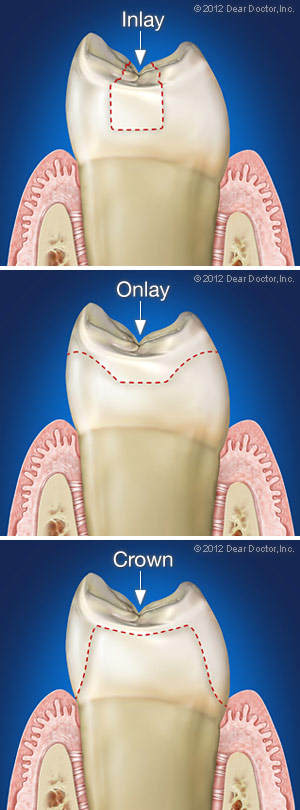

Removable Dentures
Full or partial tooth loss, if left untreated, doesn’t just affect a person’s self-image — it can also increase the risk of developing nutritional problems and other systemic health disorders. Fortunately, there’s a reliable and time-tested method for treating this condition: full or partial dentures.
Dentures are just one option for replacing missing teeth; some of the others include fixed bridgework and dental implants. Each method has its particular pluses and minuses, which should be carefully considered. There are also several varieties of dentures available to address specific issues, from partial dentures to implant-supported overdentures. The best option for you will depend on your individual situation.
Smile Makeover
Smiling with confidence makes you feel great. A beautiful smile is also an important social and professional asset. Yet there are many people who avoid showing their teeth in public or in photographs because they don’t like what they see. If that describes you, then why not start the process of getting the smile you’ve always wanted with a smile makeover?
A smile makeover goes beyond simply responding to dental problems as they arise. It’s a comprehensive smile-rejuvenation plan that’s uniquely suited to your own facial features and aesthetic preferences. The results can be quite dramatic — both in terms of how your will look and how you will feel. These are the major steps involved:

